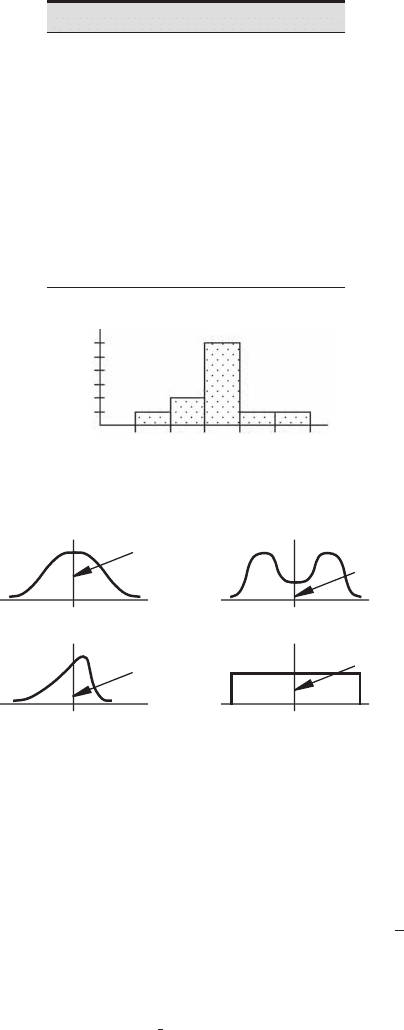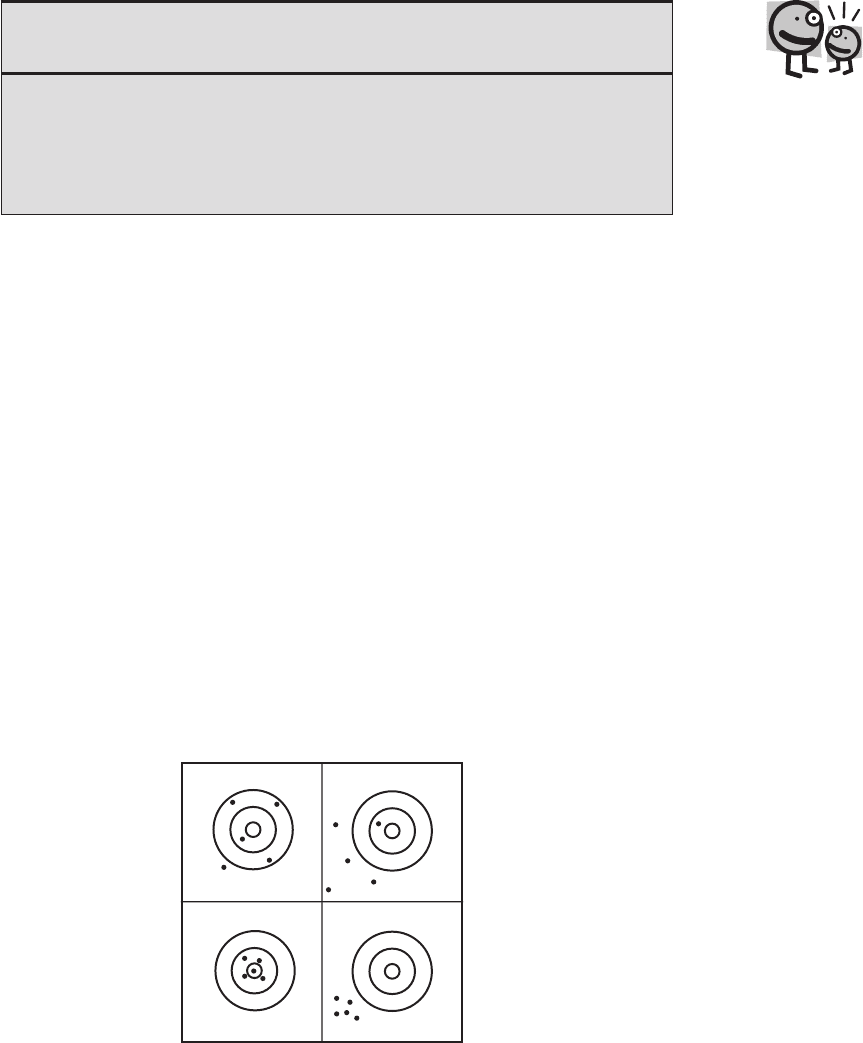Alciatore D.G., Histand M.B. Introduction to Mechatronics and Measurement Systems
Подождите немного. Документ загружается.


Confirming Pages
Figure A.1 Histogram of experimental data.
frequency
value
10 20 30 40 50 60
6
5
4
3
2
1
Table A.6 Set of experimental data
Index Value
1 25.5
2 42.1
3 36.4
4 32.1
5 15.6
6 38.6
7 55.3
8 29.1
9 32.1
10 34.0
11 35.0
Figure A.2
Distributions of data.
normal
bimodal
skewed uniform
mean
mean
mean
mean
A.3 Statistics 531
merged populations with two different means. The uniform distribution represents
completely random data.
Many data points are required to create a histogram. Statistics provides rules
for distilling the histogram down to just a few numbers representing the characteris-
tics of the data set. The most important statistical measure is the arithmetic mean,
which is also called the average or simply the mean. Denoted by x it is the sum of
each of the data values x
i
divided by the number of data points N:
x
x
i
i 1=
∑
N
------------
=
(A.2)
alc80237_appA_523-535.indd 531alc80237_appA_523-535.indd 531 19/01/11 3:57 PM19/01/11 3:57 PM

Confirming Pages
532 APPENDIX A Measurement Fundamentals
Other statistical measures that characterize a set of data are the median, which
is the data point that has an equal number of data points on both sides; the mode,
which is the value that occurs most frequently; and the geometric mean, defined as
the N th root of the product of the values:
GM x
1
x
2
. . . x
N
N
=
(A.3)
The geometric mean is more desirable than the arithmetic mean for averaging ratios
since the reciprocal of the GM is equal to the GM of the reciprocals.
For the set of data in Table A.6 , the mean is 34.2, the median is 34.0, the mode
is 32.1, and the geometric mean is 32.7.
■ CLASS DISCUSSION ITEM A.4
Statistical Calculations
Verify the calculations for the mean, median, mode, and geometric mean for the
data in Table A.6 .
■ CLASS DISCUSSION ITEM A.5
Your Class Age Histogram
In one of your class lectures, form a single line in order of birth date with the young-
est being first. Now form a birth year histogram by assembling into rows according
to birth year. Store the histogram data (year, frequency) for use in Question A.2 at
the end of the chapter.
The spread or dispersion of a data set over its range is characterized by another
statistical measure, known as the variance, defined by
v σ
2
x
i
x–()
2
N 1–
-------------------
i 1=
N
∑
==
(A.4)
where x
i
is an individual measurement and N is the total number of measurements,
called the sample size of the experiment. The standard deviation also describes
this distribution, but in the units of the individual measurements. It is defined as the
square root of the variance:
σ v
x
i
x–()
2
N 1–
-------------------
i 1=
N
∑
==
(A.5)
The standard deviation estimates the magnitude of the spread of the experimen-
tal data around the mean value. A small standard deviation indicates that the data set
has a narrow spread.
alc80237_appA_523-535.indd 532alc80237_appA_523-535.indd 532 19/01/11 3:57 PM19/01/11 3:57 PM

Confirming Pages
A.4 Error Analysis 533
A.4 ERROR ANALYSIS
The process of making measurements is imperfect, and uncertainty will always be
associated with measured values. It is important to recognize sources of error and
estimate the magnitude of error when one makes a measurement. Usually a manu-
facturer defines the accuracy of an instrument in published specifications, but other
factors come into play.
There are three types of errors: systematic errors, random errors, and blunders.
A systematic error is one that reoccurs in the same way each time a measurement
is made. The method used to minimize the magnitude of systematic error is cali-
bration, where the measurement instrument is used to record values from a stan-
dard input and is adjusted to compensate for any discrepancy. Random errors occur
due to the stochastic variations in a measurement process. Some of the statistical
tools presented in the previous section enable us to reduce the effects of these errors.
Blunders occur when the engineer or scientist makes a mistake. Blunders can be
avoided by careful design and review and through the use of methodical procedures.
Figure A.3 illustrates systematic and random errors. The center of the target
represents the desired value, and the shot pattern represents measured data. The
systematic error, called inaccuracy, is associated with the shift of the shot pattern
from the center of the target and could be corrected by improved sighting, known as
■ CLASS DISCUSSION ITEM A.6
Relationship Between Standard Deviation and Sample Size
The denominator in Equation A.5 is often confusing since one might assume it to
be N, providing a value known as the root mean square (rms). Why is the denomi-
nator ( N 1) and not N? Consider the situation where there is only one sample
( N 1). Also, consider how many data values x
i
must be specified to define the
entire data set if the mean is known.
Figure A.3 Accuracy and precision.
accurate, imprecise inaccurate, imprecise
accurate, precise
inaccurate, precise
alc80237_appA_523-535.indd 533alc80237_appA_523-535.indd 533 19/01/11 3:57 PM19/01/11 3:57 PM

Confirming Pages
534 APPENDIX A Measurement Fundamentals
calibration . The random error, called imprecision, is the size of the shot pattern and
cannot be improved by adjusting the sighting. Accuracy is the closeness to the true
value, and precision is the repeatability or consistency of the measurements.
Statistical calculations help us estimate a more precise value when a sample of
imprecise measurements is taken in the presence of random errors. The average, or
mean, provides this estimate.
A.4.1 Rules for Estimating Errors
When designing a measurement protocol to compute a parameter defined in terms
of measured variables, it is necessary to estimate the error in the parameter due to
the combined errors in the variables. A procedure for computing this overall error
follows:
1 . Prepare a table of data including the error estimate for each variable.
Generally, the estimated error contains no more than two significant figures.
2 . If the parameter to be computed is X, where X is a function of measured
variables ( v
i
),
X = X(v
1
, v
2
, . . . , v
n
)
(A.6)
compute the partial derivatives ∂ X / ∂ v
1
, ∂ X / ∂ v
2
, . . . , ∂ X / ∂ v
n
and evaluate each to
three significant figures using the recorded data ( v
1
, v
2
, . . . , v
n
).
3 . Compute the total absolute error E using
E ΔX
X∂
v
1
∂
-------
Δv
1
X∂
v
2
∂
-------
Δv
2
. . .
X∂
v
n
∂
-------
Δv
n
+++==
(A.7)
where Δ v
i
is the error in the recorded value v
i
. Round E to two significant figures.
A more conventional error measure is the root-mean-square (rms) error
given by the square root of the sum of the squares of the individual error terms:
E
rms
X∂
v
1
∂
-------
Δv
1
⎝⎠
⎛⎞
2
X∂
v
2
∂
-------
Δv
2
⎝⎠
⎛⎞
2
. . .
X∂
v
n
∂
-------
Δv
n
⎝⎠
⎛⎞
2
+++=
(A.8)
The rms error measure yields a closer approximation to the actual error.
4 . Compute X using Equation A.6 to one more decimal place than the rounded
error E. For example, if E 0.039, and X is computed to be 8.9234, then
this value is rounded to the same number of decimal places as E, giving 8.923.
When computing X, treat v
1
, v
2
, . . . , v
n
as exact numbers.
5 . The result is
X 8.923 0.039
The following list is a summary of important points to keep in mind when treat-
ing numbers and calculating errors in laboratory data analysis:
1 . Note the number of significant figures that a particular instrument displays.
alc80237_appA_523-535.indd 534alc80237_appA_523-535.indd 534 19/01/11 3:57 PM19/01/11 3:57 PM
Confirming Pages
Bibliography 535
2 . Record all values with the correct number of significant digits. If the instru-
ment display does not provide a digital output, this may require that the
observer estimate the accuracy of the measurement.
3 . Different instruments in a system may have different numbers of significant
digits.
4 . When computing results using equations, retain the appropriate number of sig-
nificant digits when performing calculations.
5 . If events can be repeated, better estimates of values can be obtained by averag-
ing. The standard deviation of these samples gives a measure of precision in
the average.
QUESTIONS AND EXERCISES
A.1. Express each of the following quantities with a more appropriate SI prefix
equivalent:
a. 100,000,000 kg
b. 0.000000025 m
c. 16.9 10
10
s
A.2. Plot the histogram and calculate the mean, standard deviation, median, mode, and
geometric mean for the data obtained from Class Discussion Item A.5.
A.3. What are the total absolute and rms errors in the calculated maximum stress of a
rectangular cantilever beam with an end load of 12,520 10 N? The beam geometry,
as measured by a metric ruler accurate to 0.5 mm, is 0.95 m long by 11.8 cm wide by
12.1 cm high. The maximum stress occurs at the wall on the surface of the beam and
is given by
σ
max
Mc
I
------- -
=
where M is the bending moment given by the product of the force and the beam
length, c is the distance from the neutral axis given by half the height, and I is the
area moment of inertia of the beam cross section given by
I
1
12
----- -
wh
3
=
where w and h are the width and height of the beam cross section, respectively.
BIBLIOGRAPHY
Beckwith , T. , Marangoni , R. , and Lienhard , J. , Mechanical Measurements, Addison-Wesley,
Reading, MA, 1993 .
Chapra , S. and Canale , R. , Introduction to Computing for Engineers, McGraw-Hill, New
York, 1994 .
Chatfield , C. , Statistics for Technology, Penguin Books, Middlesex, England, 1970 .
Doeblin , E. , Measurement Systems Applications and Design, 4th Edition, McGraw-Hill,
New York, 1990 .
alc80237_appA_523-535.indd 535alc80237_appA_523-535.indd 535 19/01/11 3:57 PM19/01/11 3:57 PM

Confirming Pages
536
Physical Principles
APPENDIX OBJECTIVES
After you read, discuss, study, and apply ideas in this appendix, you will be able to:
1. Identify possible relationships between various physical quantities
2. Identify approaches for measuring nearly all physical quantities
Sensor and transducer design always involves the application of some law or prin-
ciple of physics or chemistry that relates the variable of interest to some measurable
quantity. The following list summarizes many of the physical laws and principles
that have potential application in sensor and transducer design. Some examples of
applications are also provided. This list is extremely useful to a transducer designer
who is searching for a method to measure a physical quantity. Practically every
transducer applies one or more of these principles in its operation. The parameters
related by the respective principles are highlighted.
■ Ampere’s law: The integral of the magnetic field around a closed loop is
proportional to the current piercing the loop.
A magnetic pickup sensor uses this effect as a nonintrusive method of
measuring current in a conductor.
■ Archimedes’ principle: The buoyant force exerted on a submerged or floating
object is equal to the weight of the fluid displaced. The volume displaced
depends on the fluid density.
A ball submersion hydrometer uses this effect to measure the density of a
fl uid (e.g., automotive coolant).
■ Bernoulli’s equation: Conservation of energy in a fluid predicts a relationship
between pressure and velocity of the fluid.
A pitot tube uses this effect to measure air speed of an aircraft. Video
Demo B.1 shows an example of how to relate pressure readings to fl ow
velocity.
B
APPENDIX
Video Demo
B.1 Flow over a
cylinder in a wind
tunnel
alc80237_appB_536-540.indd 536alc80237_appB_536-540.indd 536 19/01/11 6:47 PM19/01/11 6:47 PM

Confirming Pages
Physical Principles 537
■ Biot-Savart’s law: The contribution of a current element to a magnetic field at
a point depends on the distance to the current element and the current direction.
■ Biot’s law: The rate of heat conduction through a medium is directly
proportional to the temperature difference across the medium.
This principle is basic to time constants associated with temperature
transducers.
■ Blagdeno law: The freezing temperature of a liquid drops and the boiling
temperature rises with concentration of impurities in the liquid.
■ Boyle’s law: An ideal gas maintains a constant pressure-volume product
with constant temperature.
■ Bragg’s law: The intensity of an X-ray beam diffracted by a crystal lattice
is related to the crystal plane separation and the wavelength of the beam.
An X-ray diffraction system uses this effect to measure the crystal lattice
geometry of a crystalline specimen.
■ Brewster’s law: The index of refraction of a material is related to the angle
of polarized light reflection or transmission.
A Brewster’s window on a laser tube is used to extract some of the power
in the form of a laser beam. Lasers are used extensively in measurement
systems.
■ Butterfly effect: Chaotic nonlinear systems exhibit a sensitive dependence on
initial conditions.
■ Centrifugal force: A body moving along a curved path experiences an apparent
outward force in line with the radius of curvature.
■ Charles’ law: An ideal gas maintains a constant pressure-temperature
product with constant volume.
■ Christiansen effect: Powders suspended in a liquid (i.e., a colloidal solution)
result in altered fluid refraction properties.
■ Corbino effect: Current flow is induced in a conducting disk rotating in a
magnetic field.
■ Coriolis effect: A body moving relative to a rotating frame of reference (e.g.,
the earth) experiences a force relative to the frame (see Internet Link B.1).
A Coriolis flow meter uses this effect to measure mass flow rate in a
u-tube in rotational vibration.
■ Coulomb’s law: Electric charges exert a force between each other.
■ Curie-Weiss law: There is a transition temperature at which ferromagnetic
materials exhibit paramagnetic behavior.
■ d’Alembert’s principle: Acceleration of a mass is equivalent to an equal and
opposite applied force.
■ Debye frequency effect: The conductance of an electrolyte increases (i.e., the
resistance decreases) with frequency.
■ Doppler effect: The frequency received from a wave source (e.g., sound or
light) depends on the speed of the source.
Internet Lin
k
B.1 Coriolis
effect video
demonstrations
alc80237_appB_536-540.indd 537alc80237_appB_536-540.indd 537 19/01/11 6:47 PM19/01/11 6:47 PM

Confirming Pages
538 APPENDIX B Physical Principles
A laser doppler velocimeter (LDV) uses the frequency shift of laser light
reflected off of particles suspended in a fluid to measure fluid velocity.
■ Edison effect: When metal is heated in a vacuum, it emits charged particles
(i.e., thermionic emission ) at a rate dependent on temperature.
A vacuum tube amplifier is based on this effect, where electrons are
emitted and controlled to produce amplification of current.
■ Faraday’s law of electrolysis: The rate of ion deposition or depletion is
proportional to the electrolytic current.
■ Faraday’s law of induction: A coil resists a change in magnetic field linkage
with an electromotive force.
The induced voltages in the secondary coils of a linear variable differential
transformer (LVDT) are a result of this effect.
■ Gauss effect: The resistance of a conductor increases when magnetized.
■ Gladstone-Dale law: The index of refraction of a substance is dependent on
density.
■ Gyroscopic effect: A body rotating about one axis resists rotation about other
axes (see Internet Link B.2).
A navigation gyroscope uses this effect to track the orientation of a body
with the aid of a gimbal-mounted flywheel that maintains constant
orientation in space.
■ Hall effect: A voltage is generated perpendicular to current flow in a
magnetic field.
A Hall effect proximity sensor detects when a magnetic field changes due
to the presence of a metallic object.
■ Hertz effect: Ultraviolet light affects the discharge of a spark across a gap.
■ Hooke’s Law: Axial stress in a uniaxially loaded, linear elastic material is
directly proportional to axial strain.
Resistance measurements from a strain gage can be converted to strain
readings, which can be directly related to stresses in a loaded part.
■ Johnsen-Rahbek effect: Friction at interfaces between a conductor,
semiconductor, or insulator increases with voltage across the interfaces.
■ Joule’s law: Heat is produced by current flowing through a resistor.
The design of a hot-wire anemometer is based on this principle.
■ Kerr effect: Applying a voltage across a substance can cause optical
polarization.
Liquid crystal displays (LCDs) function as a result of this principle.
■ Kohlrausch’s law: An electrolytic substance has a limiting conductance
(minimum resistance ).
■ Lambert’s cosine law: The reflected luminance of a surface varies with the
cosine of the angle of incidence.
■ Lenz’s law: Induced current flows in the direction to oppose the change in
magnetic field that produces it.
Internet Lin
k
B.2 Gyroscopic
effect video
demonstrations
alc80237_appB_536-540.indd 538alc80237_appB_536-540.indd 538 19/01/11 6:47 PM19/01/11 6:47 PM

Confirming Pages
Physical Principles 539
■ Lorentz’s force law: A current -carrying coductor in a magnetic field
experiences a force.
Based on this law, a galvanometer measures current by measuring the
deflection of a pivoted coil in a permanent magnetic field.
■ Magnetostrictive effect: a ferromagnetic material constricts when
surrounded by a magnetic field.
This effect is used by magnetoresistive linear displacement sensors (see
Video Demo B.2).
■ Magneto-rheological effect: A magneto-rheological fluid’s viscosity can
increase dramatically in the presence of a magnetic field.
■ Magnus effect: When fluid flows over a rotating body, the body experiences a
force in a direction perpendicular to the flow.
■ Meissner effect: A superconducting material within a magnetic field blocks
this field and experiences no internal field.
■ Moore’s law: The density of transistors that can be manufactured on an
integrated circuit doubles every 18 months.
■ Murphy’s law: Whatever can go wrong will go wrong and at the wrong time
and in the wrong place.
Your experiments in the laboratory will often demonstrate this law.
■ Nernst effect: Heat flow across magnetic field lines produces a voltage.
■ Newton’s law: Acceleration of an object is proportional to force acting on
the object.
■ Ohm’s law: Current through a resistor is proportional to the voltage drop
across the resistor.
■ Parkinson’s law: Human work expands to fill the time allotted for it.
■ Peltier effect: When current flows through the junction between two metals,
heat is absorbed or liberated at the junction.
Thermocouple measurements can be adversely affected by this principle.
■ Photoconductive effect: When light strikes certain semiconductor materials,
the resistance of the material decreases.
A photodiode, which is used extensively in photodetector pairs, functions
based on this effect.
■ Photoelectric effect: When light strikes a metal cathode, electrons are emit-
ted and attracted to an anode, resulting in current flow.
The operation of a photomultiplier tube is based on this effect.
■ Photovoltaic effect: When light strikes a semiconductor in contact with a
metal base, a voltage is produced.
The operation of a solar cell is based on this effect.
■ Piezoelectric effect: Charge is displaced across a crystal when it is strained.
A piezoelectric accelerometer measures charge polarization across a
piezoelectric crystal subject to deformations due to the inertia of a mass.
Video Demo
B.2 Magneto-
restrictive position
sensor
alc80237_appB_536-540.indd 539alc80237_appB_536-540.indd 539 19/01/11 6:47 PM19/01/11 6:47 PM

Confirming Pages
540 APPENDIX B Physical Principles
A piezoelectric microphone’s ability to convert sound pressure waves to a
voltage signal is a result of this principle.
■ Piezoresistive effect: Resistance is proportional to an applied stress.
This effect is partially responsible for the response of a strain gage.
■ Pinch effect: The cross section of a liquid conductor reduces with current.
■ Poisson effect: A material deforms in a direction perpendicular to an applied
stress.
This effect is partially responsible for the response of a strain gage.
■ Pyroelectric effect: A crystal becomes polarized when its temperature
changes.
■ Raleigh criteria: Relates the acceleration of a fluid to bubble formation.
■ Raoult’s effect: Resistance of a conductor changes when its length is changed.
This effect is partially responsible for the response of a strain gage.
■ Seebeck effect: Dissimilar metals in contact result in a voltage difference
across the junction that depends on temperature.
This is the primary effect that explains the function of a thermocouple.
■ Shape memory effect: A deformed metal, when heated, returns to its original
shape (see Video Demo B.3).
■ Snell’s law: Reflected and refracted rays of light at an optical interface are
related to the angle of incidence.
■ Stark effect: The spectral lines of an electromagnetic source split when the
source is in a strong electric field.
■ Stefan-Boltzmann law: The heat radiated from a black body is proportional
to the fourth power of its temperature.
The design of a pyrometer is based on this principle.
■ Stokes’ law: The wavelength of light emitted from a fluorescent material is
always longer than that of the absorbed photons.
■ Tribo-electric effect: Relative motion and friction between two dissimilar
metals produces a voltage between the interface.
■ Wiedemann-Franz law: The ratio of thermal to electrical conductivity of a
material is proportional to its absolute temperature.
■ Wien effect: The conductance of an electrolyte increases (i.e., the resistance
decreases) with applied voltage.
■ Wien’s displacement law: As the temperature of an incandescent material
increases, the spectrum of emitted light shifts toward blue.
Video Demo
B.3 Shape-
memory alloy
orthodontic wire
alc80237_appB_536-540.indd 540alc80237_appB_536-540.indd 540 19/01/11 6:47 PM19/01/11 6:47 PM
